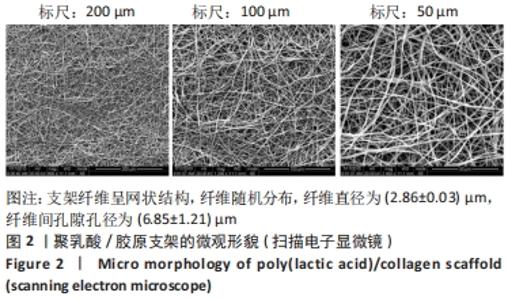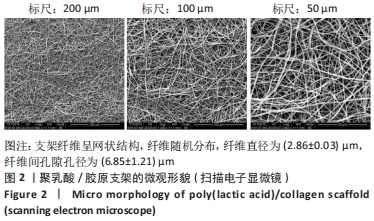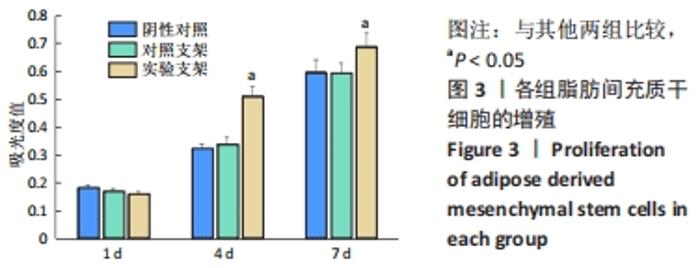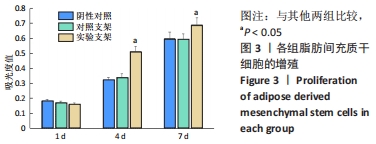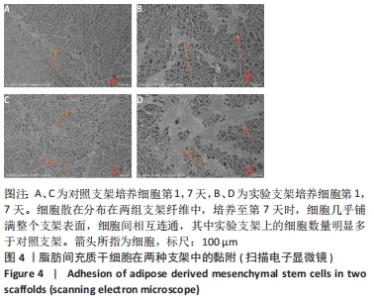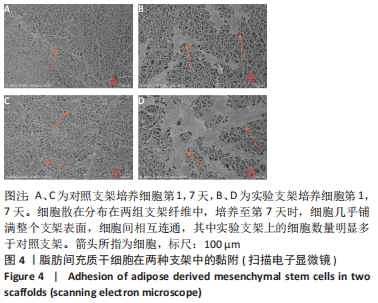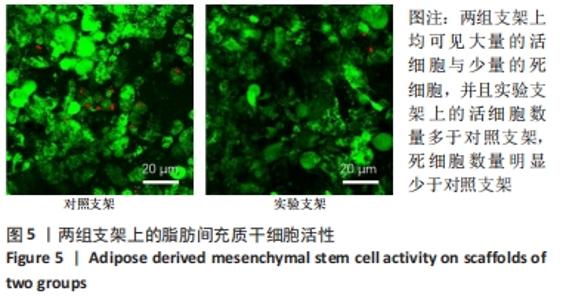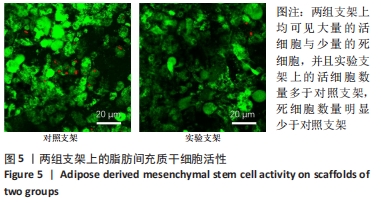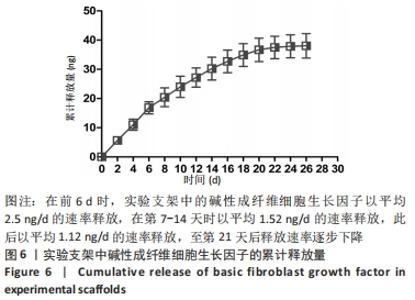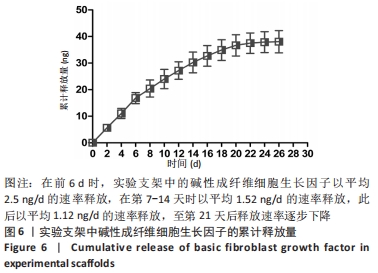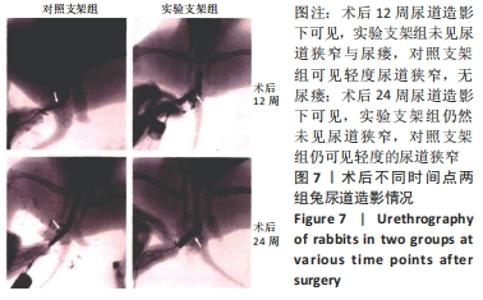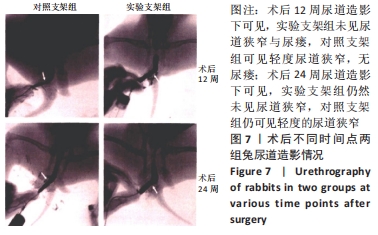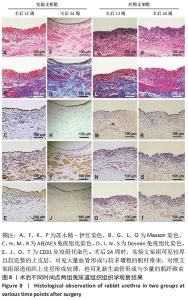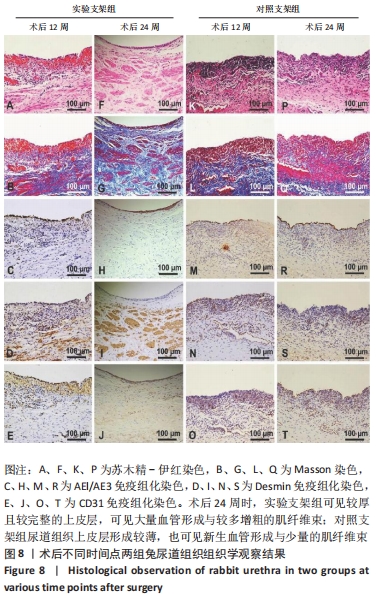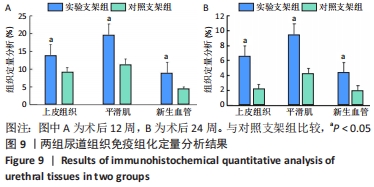Chinese Journal of Tissue Engineering Research ›› 2022, Vol. 26 ›› Issue (34): 5468-5474.doi: 10.12307/2022.457
Previous Articles Next Articles
Basic fibroblast growth factor combined with poly(lactic acid)/collagen scaffold for urethral defect in rabbits
Liu Pei, Zhang Guanying, Yu Quanfeng, Li Zeyu, Han Guangye, Wu Chunlei
- Department of Urology Surgery, First Affiliated Hospital of Xinxiang Medical College, Xinxiang 453100, Henan Province, China
-
Received:2021-04-24Accepted:2021-06-15Online:2022-12-08Published:2022-04-15 -
Contact:Wu Chunlei, Associate chief physician, MD, Department of Urology Surgery, First Affiliated Hospital of Xinxiang Medical College, Xinxiang 453100, Henan Province, China -
About author:Liu Pei, Master, Associate chief physician, Department of Urology Surgery, First Affiliated Hospital of Xinxiang Medical College, Xinxiang 453100, Henan Province, China
CLC Number:
Cite this article
Liu Pei, Zhang Guanying, Yu Quanfeng, Li Zeyu, Han Guangye, Wu Chunlei. Basic fibroblast growth factor combined with poly(lactic acid)/collagen scaffold for urethral defect in rabbits[J]. Chinese Journal of Tissue Engineering Research, 2022, 26(34): 5468-5474.
share this article
Add to citation manager EndNote|Reference Manager|ProCite|BibTeX|RefWorks
| [1] KIM SJ, LEE J, PARK CH, et al. Urethral defect due to periurethral abscess treated with a tunica vaginalis flap: A case report. Medicine (Baltimore). 2018;97(46):e13249. [2] 国平英,齐进春,陈彗,等.Duckett术治疗重度尿道下裂单中心效果观察[J].河北医科大学学报,2021,42(3):290-293. [3] JIANG SW, XU ZH, ZHAO YY, et al. Autologous granulation tissue tubes for replacement of urethral defects: An experimental study in male rabbits. J Pediatr Urol. 2018;14(1):14.e1-14.e7. [4] HMIDA W, OTHMEN MB, BAKO A, et al. Penile skin flap: a versatile substitute for anterior urethral stricture. Int Braz J Urol. 2019;45(5): 1057-1063. [5] SRIVASTAVA A, VASHISHTHA S, SINGH UP, et al. Preputial/penile skin flap, as a dorsal onlay or tubularized flap: a versatile substitute for complex anterior urethral stricture. BJU Int. 2012;110(11 Pt C):E1101-1108. [6] MARZORATI G, GHINOLFI G, PACHERA F, et al. Bladder and buccal mucosa graft in urethral stricture reconstruction. Urologia. 2008;75(3):177-179. [7] HORIGUCHI A. Substitution urethroplasty using oral mucosa graft for male anterior urethral stricture disease: Current topics and reviews. Int J Urol. 2017;24(7):493-503. [8] ZHANG K, WANG T, CAO S, et al. Multi-factorial analysis of recurrence and complications of lingual mucosa graft urethroplasty for anterior urethral stricture: Experience from a Chinese referral center. Urology. 2021:S0090-4295(21)00282-X. doi: 10.1016/j.urology.2021.03.017. Online ahead of print. [9] KAWANO PR, FUGITA OE, YAMAMOTO HA, et al. Comparative study between porcine small intestinal submucosa and buccal mucosa in a partial urethra substitution in rabbits. J Endourol. 2012;26(5):427-432. [10] RASHIDBENAM Z, JASMAN MH, HAFEZ P, et al. Overview of Urethral Reconstruction by Tissue Engineering: Current Strategies, Clinical Status and Future Direction. Tissue Eng Regen Med. 2019;16(4):365-384. [11] 史建国,王卫宁,李春吾,等.脂肪干细胞复合生物可降解材料体外构建组织工程尿道支架[J].中国组织工程研究,2019,23(13): 1989-1994. [12] ZBINDEN A, BROWNE S, ALTIOK EI, et al. Multivalent conjugates of basic fibroblast growth factor enhance in vitro proliferation and migration of endothelial cells. Biomater Sci. 2018;6(5):1076-1083. [13] OKAMURA G, EBINA K, HIRAO M, et al. Promoting Effect of Basic Fibroblast Growth Factor in Synovial Mesenchymal Stem Cell-Based Cartilage Regeneration. Int J Mol Sci. 2020;22(1):300. [14] MIYANAGA T, UEDA Y, MIYANAGA A, et al. Angiogenesis after administration of basic fibroblast growth factor induces proliferation and differentiation of mesenchymal stem cells in elastic perichondrium in an in vivo model: mini review of three sequential republication-abridged reports. Cell Mol Biol Lett. 2018;23:49. [15] LIN X, MA Y, QIAN T, et al. Basic fibroblast growth factor promotes prehierarchical follicle growth and yolk deposition in the chicken. Theriogenology. 2019;139:90-97. [16] MONCION A, LIN M, O’NEILL EG, et al. Controlled release of basic fibroblast growth factor for angiogenesis using acoustically-responsive scaffolds. Biomaterials. 2017;140:26-36. [17] JIANG P, TANG X, WANG H, et al. Collagen-binding basic fibroblast growth factor improves functional remodeling of scarred endometrium in uterine infertile women: a pilot study. Sci China Life Sci. 2019;62(12): 1617-1629. [18] BALFOUR R, BERMAN J, GARB JL, et al. Enhanced angiogenesis and growth of collaterals by in vivo administration of recombinant basic fibroblast growth factor in a rabbit model of acute lower limb ischemia: dose-response effect of basic fibroblast growth factor. Vasc Surg. 1992;2:181-191. [19] MANGIR N, WILSON KJ, OSMAN NI, et al. Current state of urethral tissue engineering. Curr Opin Urol. 2019;29(4):385-393. [20] ABBAS TO, YALCIN HC, PENNISI CP. From Acellular Matrices to Smart Polymers: Degradable Scaffolds that are Transforming the Shape of Urethral Tissue Engineering. Int J Mol Sci. 2019;20(7):1763. [21] 唐旭,张晓威,吴元翼,等.应用同种异体脱细胞真皮基质治疗前尿道狭窄的临床效果评价[J].现代泌尿外科杂志,2019,24(2):106-109. [22] 刘洋.自体尿源性干细胞结合3D多孔小肠粘膜下基质用于兔尿道重建的实验研究[D].重庆:重庆医科大学,2017. [23] 彭绪峰,罗文强,张心如,等.左氧氟沙星聚乳酸-羟基乙酸共聚物纳米微球的制备及性能分析[J].中国组织工程研究,2018,22(14): 2190-2196. [24] 张楷乐,杨熙,牛长梅,等.三维生物打印结合海藻酸钠和纤维蛋白原构建仿生尿道修复补片的实验研究[J].上海医学,2019,42(3): 164-169. [25] 林阳彦,王沫,杨勇,等.尿道上皮细胞/片状多孔丝素蛋白支架复合物修复兔尿道缺损的实验研究[J].中国男科学杂志,2016, 30(3):14-18. [26] 孔维健,方红娟,潘肃,等.搭载紫杉醇脂质体的聚乳酸-羟基乙酸共聚物静电纺丝膜对神经干细胞增殖分化的影响[J].吉林大学学报(医学版),2020,46(3):509-514. [27] SINGHVI MS, ZINJARDE SS, GOKHALE DV. Polylactic acid: synthesis and biomedical applications. J Appl Microbiol. 2019;127(6):1612-1626. [28] GAZZOLA WH, BENSON RS, CARVER W. Meltblown Polylactic Acid Nanowebs as a Tissue Engineering Scaffold.Ann Plast Surg. 2019;83(6): 716-721. [29] CHOWDHURY SR, MH BUSRA MF, LOKANATHAN Y, et al. Collagen Type I: A Versatile Biomaterial. Adv Exp Med Biol. 2018;1077:389-414. [30] NAZIR R, BRUYNEEL A, CARR C, et al. Collagen type I and hyaluronic acid based hybrid scaffolds for heart valve tissue engineering. Biopolymers. 2019;110(8):e23278. [31] WALIMBE T, CALVE S, PANITCH A, et al. Incorporation of types I and III collagen in tunable hyaluronan hydrogels for vocal fold tissue engineering. Acta Biomater. 2019;87:97-107. [32] 提运荣,杨孟波,张明,等.脂肪来源间充质干细胞治疗神经损伤性勃起功能障碍的实验研究[J].中国男科学杂志,2021,35(1):32-37. [33] 张传辉,李建军,杨军. 动态压力联合胰岛素样生长因子1基因转染对壳聚糖/明胶支架中兔脂肪间充质干细胞成软骨分化的影响[J].中国组织工程研究,2021,25(28):4485-4491. [34] 石磊,周伟东,马骏杰,等.脂肪间充质干细胞双向诱导上皮/平滑肌细胞膜片修复兔尿道缺损[J].同济大学学报(医学版),2020, 41(5):561-566. [35] 丁玉芹,姜宏.丝裂原活化蛋白激酶信号转导通路与精子活动力[J].国际生殖健康/计划生育杂志,2009,28(4):38-40. [36] ZHAO T, ZHAO W, CHEN Y, et al.Acidic and basic fibroblast growth factors involved in cardiac angiogenesis following infarction. Int J Cardiol. 2011;152(3):307-313. [37] 代志鹏,杨泊宁,焦竞博,等.重组人bFGF对骨髓间充质干细胞增殖和细胞周期的影响[J].中华显微外科杂志,2020,43(5):486-488. [38] 卫秀洋,王万明,陈勇忠,等.胶原蛋白海绵复合bFGF促进兔胫骨外露创面愈合的实验研究[J].中国医药指南,2012,10(23):399-401. [39] 卞徽宁,陈华德,郑少逸,等.外源性碱性成纤维细胞生长因子对创面愈合病理变化的影响[J].感染、炎症、修复,2006,7(4):206-209,封3. |
| [1] | Yao Xiaoling, Peng Jiancheng, Xu Yuerong, Yang Zhidong, Zhang Shuncong. Variable-angle zero-notch anterior interbody fusion system in the treatment of cervical spondylotic myelopathy: 30-month follow-up [J]. Chinese Journal of Tissue Engineering Research, 2022, 26(9): 1377-1382. |
| [2] | Liu Feng, Peng Yuhuan, Luo Liangping, Wu Benqing. Plant-derived basic fibroblast growth factor maintains the growth and differentiation of human embryonic stem cells [J]. Chinese Journal of Tissue Engineering Research, 2022, 26(7): 1032-1037. |
| [3] | Zhang Jinglin, Leng Min, Zhu Boheng, Wang Hong. Mechanism and application of stem cell-derived exosomes in promoting diabetic wound healing [J]. Chinese Journal of Tissue Engineering Research, 2022, 26(7): 1113-1118. |
| [4] | An Weizheng, He Xiao, Ren Shuai, Liu Jianyu. Potential of muscle-derived stem cells in peripheral nerve regeneration [J]. Chinese Journal of Tissue Engineering Research, 2022, 26(7): 1130-1136. |
| [5] | Tan Guozhong, Tu Xinran, Guo Liyang, Zhong Jialin, Zhang Yang, Jiang Qianzhou. Biosafety evaluation of three-dimensional printed gelatin/sodium alginate/58S bioactive glass scaffolds for bone defect repair [J]. Chinese Journal of Tissue Engineering Research, 2022, 26(4): 521-527. |
| [6] | He Yunying, Li Lingjie, Zhang Shuqi, Li Yuzhou, Yang Sheng, Ji Ping. Method of constructing cell spheroids based on agarose and polyacrylic molds [J]. Chinese Journal of Tissue Engineering Research, 2022, 26(4): 553-559. |
| [7] | He Guanyu, Xu Baoshan, Du Lilong, Zhang Tongxing, Huo Zhenxin, Shen Li. Biomimetic orientated microchannel annulus fibrosus scaffold constructed by silk fibroin [J]. Chinese Journal of Tissue Engineering Research, 2022, 26(4): 560-566. |
| [8] | Chen Xiaoxu, Luo Yaxin, Bi Haoran, Yang Kun. Preparation and application of acellular scaffold in tissue engineering and regenerative medicine [J]. Chinese Journal of Tissue Engineering Research, 2022, 26(4): 591-596. |
| [9] | Kang Kunlong, Wang Xintao. Research hotspot of biological scaffold materials promoting osteogenic differentiation of bone marrow mesenchymal stem cells [J]. Chinese Journal of Tissue Engineering Research, 2022, 26(4): 597-603. |
| [10] | Shen Jiahua, Fu Yong. Application of graphene-based nanomaterials in stem cells [J]. Chinese Journal of Tissue Engineering Research, 2022, 26(4): 604-609. |
| [11] | Wang Ruanbin, Cheng Liqian, Chen Kai. Application and value of polymer materials in three-dimensional printing biological bones and scaffolds [J]. Chinese Journal of Tissue Engineering Research, 2022, 26(4): 610-616. |
| [12] | Zhang Tong, Cai Jinchi, Yuan Zhifa, Zhao Haiyan, Han Xingwen, Wang Wenji. Hyaluronic acid-based composite hydrogel in cartilage injury caused by osteoarthritis: application and mechanism [J]. Chinese Journal of Tissue Engineering Research, 2022, 26(4): 617-625. |
| [13] | Li Hui, Chen Lianglong. Application and characteristics of bone graft materials in the treatment of spinal tuberculosis [J]. Chinese Journal of Tissue Engineering Research, 2022, 26(4): 626-630. |
| [14] | Gao Cangjian, Yang Zhen, Liu Shuyun, Li Hao, Fu Liwei, Zhao Tianyuan, Chen Wei, Liao Zhiyao, Li Pinxue, Sui Xiang, Guo Quanyi. Electrospinning for rotator cuff repair [J]. Chinese Journal of Tissue Engineering Research, 2022, 26(4): 637-642. |
| [15] | Zhang Shengmin, Cao Changhong, Wang Ningning, Wang Jing, Li Zhangyi. Desferrioxamine-loaded polylactic-co-glycolic acid/hydroxyapatite composite scaffold: vascularization and osteogenesis [J]. Chinese Journal of Tissue Engineering Research, 2022, 26(34): 5413-5418. |
| Viewed | ||||||
|
Full text |
|
|||||
|
Abstract |
|
|||||
